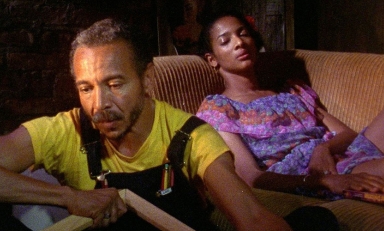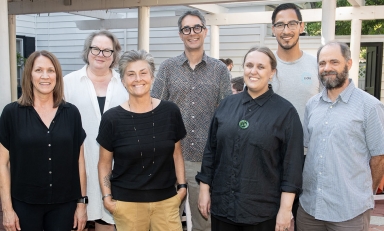
Associate Professor of Media Arts & Culture Aleem Hossain recently premiered his new film, which was created with AI tools and explores the intersection of artificial intelligence, identity, and colonialism.
Do Banglandroids Dream of Electric Tagore? is a three-minute film that premiered at Fantastic Fest, the largest genre film festival in the U.S. The film takes the perspective of a documentarian investigating a group of abandoned androids in the New Jersey Exclusion Zone, the site of a previous failed robot uprising. Left to themselves in what is now a wasteland, the droids obsess over the only information remaining in their memory banks: the works of Bengali Renaissance poet Rabindranath Tagore.
Hossain is a lifelong science-fiction fan, and his appreciation for the genre shines through in Banglandroids’ homages. The film’s title refers to Do Androids Dream of Electric Sheep?, the classic dystopian Philip K. Dick novel on which Ridley Scott’s film Blade Runner was based. Like Dick and Scott, Hossain is interested in examining humans’ moral responsibility toward our creations, and how axes of oppression might develop within the creator-creation dynamic.
But the film also addresses science fiction’s shortcomings, particularly the genre’s historical lack of inclusivity. Hossain’s work is centered in Desi-futurism, a movement that includes diverse South Asian diasporic visions of the future that often push back against colonialism and oppression.
“I’m particularly interested in making not just South Asian-focused sci-fi, but in making South Asian American sci-fi,” Hossain says. “I’m a mixed-race American: my mother is a white woman born and raised in New England in a Catholic household, and my father is a Muslim Bangladeshi immigrant. I’m making sci-fi stories from that mixed-race, multicultural, American starting point.”
From this viewpoint, Banglandroids draws inspiration from contemporary geopolitical dynamics, including the world’s economic reliance on the Global South for clothing, electronics, and other consumer goods. The film’s New Jersey setting raises questions about how current power structures might extend into a future where robots, built and programmed primarily in the Global South, serve societies dominated by the Global North.
“I specifically wanted to explore these questions through the lens of race and colonialism,” Hossain says. “What if we oppress AI instead of being oppressed by it?”
It’s a topic with which science fiction has only recently started grappling. Although the genre thrives on exploration plots, those narratives have often echoed colonial themes. Protagonists are depicted as “discoverers” of aliens and planets, rather than invaders; their long-term negative impact on these societies is rarely examined; and inherent traits are ascribed to different cultures and species (such as the always-logical Vulcans or perpetually scheming Ferengi in Star Trek).
And while these fantastical stories have real-world analogies, they’re rarely told by those who have experienced the inequities following historical “discoveries.” Despite filmmaking’s digital revolution in the late 1990s and early 2000s, sci-fi films with complex effects and elaborate sets are still prohibitively expensive to make, requiring specialized equipment and significant time investments.
On the most basic level, I want to make the case for the continued need to have humans involved in creating art.
“There are very few people who get the opportunity to spend that money, burn that time, or use that equipment, and the system does not hand out those chances equitably,” Hossain says.
He believes that ethical AI filmmaking tools could potentially disrupt this status quo, making it more feasible for BIPOC, queer, female, and disabled filmmakers to produce ambitious projects while preserving a human-centered approach to cinematic storytelling. Although he used AI to bring his short film’s visuals to life, Hossain emphasizes that the essence of the Banglandroids project was deeply human: he came up with the idea, wrote the screenplay, and drafted and repeatedly refined the image generation prompts.
“This project was me, a human artist, using AI as a tool,” he says, noting that Fantastic Fest attendees responded warmly to both the film’s content and the methods behind its creation. “It was really wonderful to have audience members and other filmmakers come up to me excited about what these AI tools allowed me to create.”
Still, Hossain is deeply concerned about AI developers’ disregard for intellectual property and labor, a concern that dissuades him from using the technology to create a commercial release. Unregulated, AI mimics those traditional sci-fi narratives: a “discovery” based on appropriating others’ resources, with little regard for how that extraction might destroy their way of life.
“On the intellectual property front, tech companies have made it impossible for me, as an artist, to fully address my fear about copyright infringement because they won’t disclose enough information,” he says. “These companies are failing in their responsibility to provide transparency and to develop safeguards. I think we’ll need legislation, lawsuits, labor action, and society-wide pressure to do that.”
It’s one of the reasons why Hossain is adamant that artists should play a key role in AI’s evolution. Because AI technology is trained on existing material, the lack of human input heightens the risk of “a feedback loop of underrepresentation” in which the same types of stories and characters are regurgitated, leaving underrepresented creators worse off than before.
“I want my voice as an artist, not just the voices of big tech and big business, to be shaping how this technology is used,” he says. “And on the most basic level, I want to make the case for the continued need to have humans involved in creating art.”
For now, Bangladroids will continue on the festival circuit. Hossain is planning an on-campus screening on Feb. 6, 2025, along with an online release.



